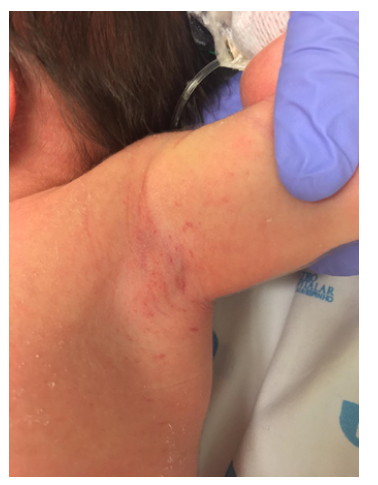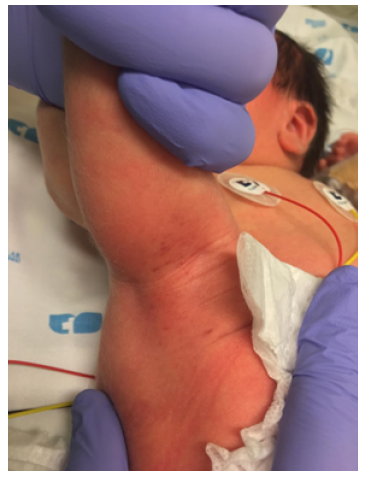The present case refers to a full-term newborn from a first pregnancy without complications, who was routinely examined on the first day of life. The mother’s routine serologic tests and prenatal ultrasounds were unremarkable. She had no relevant health issues, including immune thrombocytopenia or autoimmune diseases, and was not taking any usual medications. Her hemogram showed a hemoglobin of 10.9 g/dL, a leukocyte count of 14,850/µL, and a platelet count of 211,000/µL. Delivery was vacuum assisted and the child had an Apgar score of 9/10/10. The rupture of membranes occurred 14 hours prior to delivery and no other infectious risk factors were present. Anthropometric measurements were in the 10-50th percentile. During observation, the newborn appeared well with no obvious congenital anomalies. Multiple petechiae were noted on the axillary, inguinal, and popliteal folds and on the lower abdomen, without any other physical examination findings, including signs of bleeding or mucosal involvement (Figures 1and2). Blood work was performed and showed thrombocytopenia of 28,000/ul with normal remaining blood cell lines and serial negative C-reactive protein.
What is your diagnosis?
Diagnosis
The main hypothesis is neonatal alloimmune thrombocytopenia (NAIT).
Given the probable diagnosis of NAIT, one dose of intravenous immunoglobulin was administered. A control blood test showed a minimum platelet count of 25,000/ul eight hours after immunoglobulin administration, rising to 44,000/ul after eighteen hours. Because of the high index of suspicion for this diagnosis, an expectant approach was adopted, with monitoring of the neonate and immunoglobulin response before deciding to proceed with platelet transfusion. A compatible platelet concentrate was requested, but was unnecessary after the positive response to immunoglobulin administration. A transfontanelar ultrasound was performed to rule out intracranial hemorrhage. A second dose of immunoglobulin was given after 24 hours. The platelet count progressively increased to 176,000/ul on day seven. The diagnosis was confirmed on day five. Parental testing revealed maternal antiplatelet anti-HPA-1a alloantibodies. The parents’ platelet compatibility test was strongly positive (4+), and the maternal, paternal, and neonatal platelet HPA-1 genotypes were 1b1b, 1a1a, and 1a1b, respectively. At two months of age, the infant was clinically well and had a platelet count of 415,000/ul.
NAIT is a rare disease of the newborn (incidence of 1/1000 to 10000 births) that occurs when the mother develops antiplatelet antibodies to fetal platelets1)-(5 and should be considered in the differential diagnosis of isolated petechiae of the newborn. Because it often presents with subtle signs in mostly otherwise well-appearing newborns, a thorough physical examination of the infant is essential.2 Although most cases are mild, NAIT is a significant cause of morbidity and mortality in newborns and the most common cause of intracranial hemorrhage (ICH) in term infants.3 Approximately 7-20% of newborns affected by NAIT develop ICH, with up to 75% of these cases occurring antenatally.4 The diagnosis is confirmed by the presence of maternal antihuman platelet antibodies.3,4) Treatment of the condition includes platelet transfusion with compatible platelet concentrates when the platelet count is below 25,000-30,000/µL and especially when severe bleeding is present.3,5) The use of intravenous immunoglobulin may be the initial therapeutic approach while waiting for compatible platelets. NAIT tends to be more severe in subsequent pregnancies, so serologic and genetic testing are important, not only to confirm the diagnosis, but also to provide appropriate genetic counseling to the couple and adequate management of future pregnancies.3 This may include serial percutaneous umbilical blood sampling, maternal intravenous immunoglobulin and steroid administration, and fetal platelet transfusions.4) The timing of delivery is variable, with delivery recommended by elective cesarean in earlier gestational age for severe disease.3,4

















